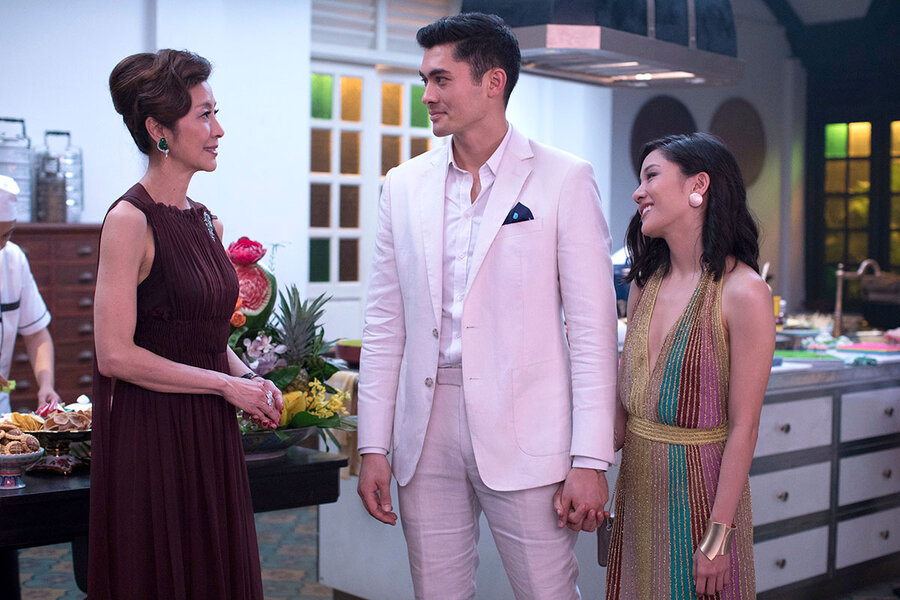Can ‘Crazy Rich Asians’ help redefine how Hollywood portrays Asians?
Loading...
When Patrick Nan heard about “Crazy Rich Asians,” he says he thought, “This is finally our turn to enter into mainstream Hollywood, for Asians to be finally portrayed authentically.” The film, which opens Aug. 15, is rare – one of the first movies from a major studio with a contemporary, all-Asian cast since “The Joy Luck Club” in 1993. Based on the bestselling book by Kevin Kwan, the story follows Rachel Chu (Constance Wu) as she travels to Singapore with her boyfriend, Nick Young (Henry Golding), for his best friend’s wedding. She finds out that he’s, well, crazy rich. Hollywood has a history of misrepresenting Asians, and rarely portrays them in romantic relationships. This film hopes to change that. With so few movies like it, the pressure for it to do well at the box office and to represent an entire community is high. If Hollywood produces more films about Asian-Americans, “not every single movie will have to hold up the expectations and hopes of an entire community,” says blogger Phil Wu. “A movie like this can be allowed to fail.”
Why We Wrote This
Historically, Hollywood has misrepresented Asians. Understanding how offers lessons on more authentically portraying minorities, eventually making movies like "Crazy Rich Asians" expected rather than exceptions.
Phil Yu couldn’t remember a time he had seen two Asian romantic leads on a poster for a Hollywood film.
But there it was in late April – a poster for “Crazy Rich Asians” with its leads, Constance Wu and Henry Golding, embracing each other beneath the tagline: “The only thing crazier than love is family.”
He has since attended two screenings of the movie, which he describes as a powerful emotional experience.
Why We Wrote This
Historically, Hollywood has misrepresented Asians. Understanding how offers lessons on more authentically portraying minorities, eventually making movies like "Crazy Rich Asians" expected rather than exceptions.
“Asian-Americans, just like anyone else, deserve to see stories ... [with] characters who look like us from our community having fun and falling in love.... It means a lot to see yourself reflected in this everyday way,” says Mr. Yu, who runs the blog “Angry Asian Man.”
The film, which opens Aug. 15, is an extreme rarity – one of the first movies from a major Hollywood studio with a contemporary, all-Asian cast since “The Joy Luck Club” in 1993. It may also breathe new life into the romantic comedy genre. “Crazy Rich Asians” is projected to rake in $26 million in its first five days, a debut not seen for a rom-com since 2015, and currently has a 98 percent Rotten Tomatoes rating. It’s also under outsized pressure to succeed; after decades of misrepresentation, for many of Asian descent it marks a chance to finally be seen.
“Crazy Rich Asians” is based on the international bestselling book by Singaporean-American author Kevin Kwan. The story follows Rachel Chu (Wu), an Asian-American professor from New York, as she travels to Singapore with her boyfriend, Nick Young (Golding) for his best friend’s wedding. She finds out that he’s, well, crazy rich.
When Patrick Nan, a rising junior studying film at Pitzer College in Claremont, Calif., heard about “Crazy Rich Asians,” he says he thought, “This is finally our turn to enter into mainstream Hollywood, for Asians to be finally portrayed authentically.” Asian and Asian-American characters, he hoped, would no longer be only kung fu experts or computer geeks who can’t get a date.
A history of misrepresentation
Hollywood rarely portrays Asians and Asian-Americans in romantic relationships, says Peter X Feng, an Asian-American English professor at the University of Delaware in Newark, and author of “Identities in Motion: Asian American Film and Video.” “Crazy Rich Asians” is asking the audience to identify with the Asian-American female lead, “a big shift” from the history of representing Asian-American women as “a trophy or a prize” who are hypersexual and extremely feminine, says Professor Feng. Asian men, in contrast, are depicted as either being sexually deviant or comically devoid of sexual desire, he adds.
A part of the emasculated way Asian men are portrayed in Hollywood comes from an American anxiety about Asian wealth, one that is not directed at other Western nations, adds Feng.
“‘Crazy Rich Asians’ is set among these families who… just like the Kardashians or the Trumps, are ostentatiously spending their money in ridiculous ways,” says Feng. The film bolsters Western values about consumerism and displays of wealth rather than represent Asian wealth as a threat, he adds.
Jamie Kho, a 14-year-old Chinese teenager who lives in the Philippines, has bonded with her 50-something parents while reading the books because they identify with the characters. “Although I’m not crazy rich, there are a lot of aspects, especially when it comes to culture and tradition about respect, I can identify myself in,” she says. She was captivated by the story’s depiction of generational struggle, calling it “the perfect blend of old and new.”
As actors were chosen, many questioned the casting of Golding, who is British-Malaysian and biracial, to play the Chinese-Singaporean lead role. Others criticized the film for not reflecting the diversity of Singapore, comprised of ethnic Chinese (76 percent of population), Malays (15 percent), and Indians (7 percent).
The scrutiny is a result of a history of yellowface in Hollywood that continues with the practice of whitewashing, where a white actor plays an Asian character, says Jun Okada, associate professor of English at the State University of New York Geneseo. Prominent examples include Scarlett Johansson as a cybernetic Japanese woman in “Ghost in the Shell” (2017) and Tilda Swinton as the Ancient One in “Doctor Strange” (2016). In fact, one producer who wanted to option “Crazy Rich Asians” suggested they make Rachel's character white, a change the book’s author refused.
The history of yellowface – using everything from skin-darkening pigments to tape and rubber bands to alter the appearance of white actors – stretches back to mid-18th century theater. Actors from Katherine Hepburn and Marlon Brando to Fred Astaire and John Wayne took part in the practice.
“I'm fine with a white actor being cast in an Asian role, as long as it's in a world where an Asian actor can be cast in a white role. But the system is unbalanced,” says Feng.
An increasingly global Hollywood
Often, projects about minories catapult certain actors’ careers rather than leading to more films telling diverse stories, says Feng.
“If this movie does well it will hopefully open doors. But I can't tell you how many times I've said that before,” Feng says, listing the movie “The Joy Luck Club,” and the Asian-led TV shows “All American Girl” (1994) and current ABC show “Fresh Off the Boat," the first network sitcom starring Asian-Americans to reach syndication. “I think we are seeing incremental change, but I don't think we're seeing transformative change,” he adds.
That landscape includes a few other studio films with all-Asian casts like “Memoirs of a Geisha” (2005), independent films starring Asian Americans like “Better Luck Tomorrow” (2002), and films made by non-American production companies with US releases like Indian-American film “The Namesake” (2006).
According to a 2017 study by the University of Southern California Annenberg's School for Communication and Journalism, 4.8 percent of speaking characters in Hollywood films in 2017 were Asian, despite making up 5.7 percent of the US population. Nearly two-thirds of the top 100 films that year didn’t have a single Asian or Asian-American female character.
The film's $30 million budget was financed through a combination of American and Asian production companies, which to Feng demonstrates the increasingly global nature of the film marketplace.
“The question of representation can’t be divorced from the economics,” says Feng, who says he expects more Hollywood films starring Asians because of the growing market in Asia. Chinese moviegoers are increasingly important to Hollywood with China accounting for $7.9 billion in ticket sales in 2017, fueling a 7 percent increase in overall box office earnings for US films.
With so few movies like it, the pressure for the film to do well at the box office and to represent an entire community is high. “It’s under a huge magnifying lens,” says Professor Okada.
Eventually, if more films about Asian-Americans get made, “not every single movie will have to hold up the expectations and hopes of an entire community,” says Yu, the blogger. “It can just be another movie. And a movie like this can be allowed to fail.”








